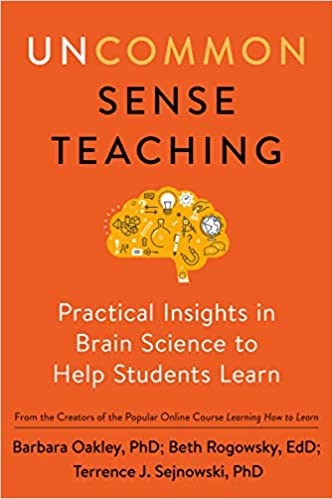
Uncommon Sense Teaching: Practical Insights in Brain Science to Help Students Learn by Barbara Oakley, Beth Rogowsky, and Terrence Sejnowsk
t explains how the brain works when it learns. It also offers lots of practical real world advice for teachers and learners of all ages. No school professional development library should be without it.
1. Building Memory: How Students Fool Themselves into Thinking They’re Learning
- Information in working memory generally goes away when we stop thinking about it. This can fool students into thinking they really know something. What they need to do is right after they have encountered new information, they should see if they can retrieve it from long-term memory. Retrieval practice is one of the best techniques for strengthening new information in long-term memory. The more times you retrieve something the stronger your memory of it will be. Students should jot notes about what they just learned and compare their notes with other students. Retrieving information from previous days or weeks is called spaced repetition, which further strengthens long-term memory.
2. Teaching Inclusively: The Importance of Working Memory
- Not all students have the same amount of working memory. For those with less, it’s vital to build their long-term memory, which will make the short-term memory they have more efficient. Working memory increases over time until children reach the age of about 14. Engaging students’ interests makes learning more effective while stress gets in the way.
- Slower learners can benefit from reteaching, giving them more time to practice, giving them outlines to take notes on, and breaking things down into simpler steps. For faster learners go beyond factual questions, have them work together, increase the complexity of assignments, have extra activities for them to do, and let them devise their own activities. This helps you differentiate your teaching. In all cases, active practice should break up teacher talk.
3. Active Learning: The Declarative Pathway
- Research shows that active learning is much more effective than simply listening to an expert. Note that not all hands-on activities are considered to be active learning. Active Learning engages students in the process of learning through activities and/or discussions in class. It emphasizes higher-order thinking and often involves group work. The foundation for conceptual understanding and creative thinking is the storage of basic facts and procedures in long-term memory. Note-taking and retrieval practice facilitate this process.
- Long-term memories are stored in the neocortex, which is the big front and top of your brain. The process is facilitated by the hippocampus, which is composed of two small bean-shaped pieces at the base. It acts as an index while the connections of neurons that store memories are being made. Retrieving recently stored memories serves to help consolidate the information. Much of this consolidation occurs while we are sleeping. Brief breaks of even less than a minute can help students make sense of new material. Index links from the hippocampus dissolve after a while, which is why cramming the night before doesn’t work as there is no time for consolidation.
- Frequent formative assessments, low-stakes tests, homework, and exercises can all help with retrieval. Daily physical exercise of an hour or more helps with the formation of neuron connections. Be sure to tap into prior knowledge. Use the think-pair-share method when teaching. Students will find that working in pairs or groups of three or four is more effective than larger-sized groups. If possible, pick a shy person from a group with the right answer (or a good answer) to present to the class.
DrDougGreen.com If you like the summary, buy the book





